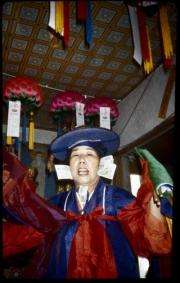South Korean shamans fluidly absorb cultural change

spurred by the world's fastest-growing economy from the 1960s to the 1990s—has rapidly developed, shamans and the rituals they perform have adapted to their new hyper-modern landscape and transformed their work in the process. During this time, the South Korean countryside has almost completely disappeared, old shrines have been crowded out by urban development, clients turn to cell phones to connect to shamans, and most shamans now chant, sing, and mime their rituals in anonymous rented commercial space. While old village women once judged the competence of aspiring shamans, today's clients often do not know what to expect from a shamanic ritual. Decades ago, rituals redressed domestic conflicts or illness. Today, shamans are often hired to relieve business-related anxiety. After thirty years of fieldwork that began in a rural village and recently moved to cities, Laurel Kendall, curator and division chair of Anthropology at the American Museum of Natural History, explores in a new book how shamans have absorbed the profound changes in their culture to remain relevant.
"The shamans manifest gods whose anger wreaks havoc but whose benevolence brings boundless fortune, an idea of volatile divine intervention that is suitable for both the 21st century's global economy and the business problems experienced by small entrepreneurs," says Kendall. "Skillful shamans deal with people's needs, fear, and anxiety about doing business in a risky environment."
Shamans are religious practitioners who engage the spirits on behalf of the community, either by journeying to other realms or by bringing them into the here and now by manifesting them in their own bodies, in the case of South Korean shamans. To Kendall, this is an inherently adaptable, creative domain of religious practice because spirits report from "out there."
"Korean shaman rituals are the opposite of Confucian ancestor veneration as practiced in many South Korean homes—the Emily Post of rituals," says Kendall. "Confucian ancestors are a mute presence. But in shaman ritual, gods, ancestors, and ghosts are anything but quiet. They act out the client family's own history and speak to the family's most immediate needs and concerns. A skilled Korean shaman, and the spirits she evokes, cause the client weep and laugh. It is a cathartic experience, a sacred theater that acts on people's lives, a religious psycho-drama."
Kendall first became interested in Korean shamans after watching a female shaman, fantastically dressed and possessed by a very angry deity, "grab the man of the house by the ear and give him a tongue lashing." She decided that she wanted to know "how the shaman got away with it." Kendall's first book, Shamans, Housewives, and Other Restless Spirits (1985), framed shamanism as it was at the time: as an integral part of village life. Interested in why people turned to shamans and how shamans helped their clients, Kendall found that women sought shamans to take care of the family's pantheon of gods and to gain blessings for the household. The ritual, or kut, helped members of a household work through their problems, deal with an illness, and less frequently relieve money worries. The kut were as surprising and varied as the individual households in which they took place.
Kendall's new book discusses the recent changes to the kut as a reflection of how South Koreans have engaged with their changing society. Many people have moved to cities and to apartment blocks with little residential space; rooms are too narrow to accommodate dancing shamans, and neighbors complain about the accompanying drum and cymbals. At the same time, urban South Koreans, like city people elsewhere, are less likely to know their neighbors than village people did, and prefer to not air their dirty linen in a public shamanic ritual. Consequently, clients, shamans, and others now pile into vans or SUVs with their costumes, equipment, and offering food—which sometimes includes an entire steamed pig—to drive to a commercial shrine for the kut.
The new lack of social and physical context in kut leads to a new set of worries among clients. Although they feel the need to engage the services of a shaman, few clients have seen shamans in action and are uncertain how to judge a shaman's competence and diagnosis. Another change brought by the fluid, developed country is that most kut are now held to address business failure, the quirkiness of the market, or anxiety about money in general. Kendall found that about two thirds of rituals currently performed address these concerns rather than more personal needs.
"In the 21st century, with a global economy, the complexity of international trade, and the need to work through middlemen, there is a huge dimension of unknown in the lives of small business people," says Kendall. "The kut gives these South Koreans an image of possible blessing to carry with them into their risky lives."
"A poetic imagery of contemporary aspirations emerges in a contemporary kut when the gods sing of 'raising tall buildings,' promise customers who 'pay with credit and not cash,' and evoke the sound of shop door constantly opening to admit more customers," Kendall continues. "Korean shamans (and their spirits) have much to tell us about hopes and anxieties of contemporary South Koreas. They underscore the creativity and adaptability of popular religious responses to an uncertain world."
Provided by American Museum of Natural History













